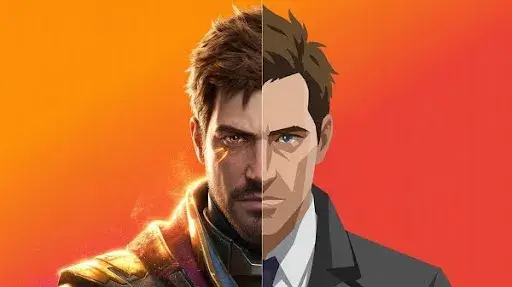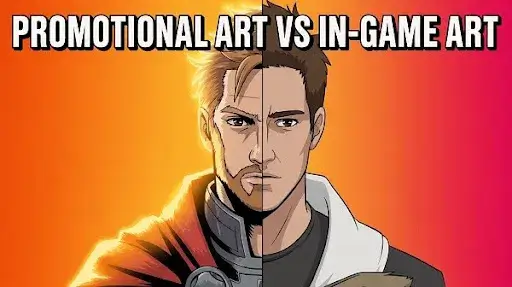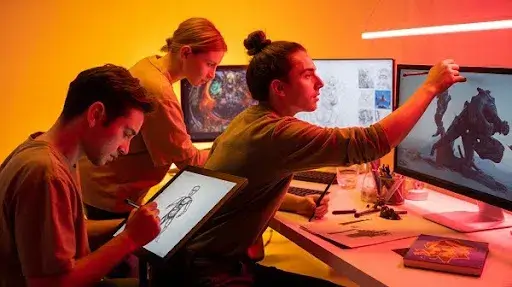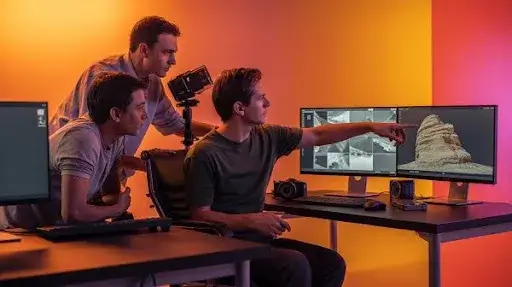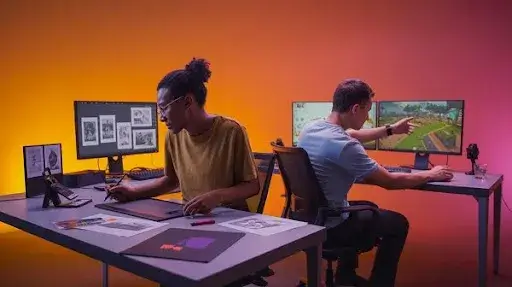A gamer once said this in a forum, dead serious:
“The trailer made me feel like a hero. The game made me check the settings to see if something broke.”
Harsh? Maybe. True? Often, yes. The reason is simple. What sells a game is not always what plays inside the game.
There’s a world of difference between promotional art vs in-game art. They look like siblings. They behave like distant cousins. One’s job is to make you stop scrolling. The other’s job is to make you stay up till 3 a.m. And if you actually understand this difference, you’ll never watch a game trailer the same way again.
Types of Art That Make Games
Every game you love runs on two different creative engines. One is built to catch your emotions. The other is built to handle your console, PC, or phone without exploding.
When studios like Prolific Studio work on projects that include game animation services, they know one rule better than most: If it sells well but plays badly, players don’t come back. If it plays well and also sells well, you’ve built a fanbase.
Let’s break both art forms down properly.
What is In-Game Arts?
It’s every visual element you see while playing. The streets, shadows, explosions, characters, health bars, weapons, sky, maps, and menus. Everything.
This art has a checklist, and it’s not gentle:
- Must run without crashing the device
- Must work across low-end and high-end screens
- Must load fast, usually in seconds
- Must animate smoothly inside real gameplay
- Must never eat system memory like a hungry monster
A single frame in the game doesn’t get hours of luxury polishing. Why? Because games don’t run at a single frame rate. They run on thousands of frames every minute, stitched together to feel alive.
If in-game art tries to look as heavy as promotional art, the device cries. Frames drop. Fans spin. Gamers scream. So the art is clever instead of heavy.
Game artists reduce detail where it won’t matter and enhance detail where the player actually looks. They fake depth. They fake shine. They fake complexity.
Players never notice. Their brains fill in the rest. That’s the genius of modern game art trends. Fewer polygons. More illusion. Less pressure. More charm.
What is Promotional Art?
It’s freedom. No performance limits. No device restrictions. No memory warnings. No lag. Just pure, unfiltered visuals built to make someone whisper, “I need to play this.”
This is where studios flex their amazing promotional art muscles. Your character’s armor can shine like it was polished by angels. The fire can dance like it rehearsed its role for 6 months. The background can have 90 layers of detail that nobody will ever question.
A single 10-second promotional clip can take weeks to craft. One image can get more attention than 80% of the actual game scenes. It’s visual persuasion at its finest. This is why game trailers often look like Hollywood’s younger cousin. They’re not real gameplay. They’re a mood board that learned motion.
Promotional Art vs In-Game Art: The Core Difference
At the surface, both exist to represent the same game. Under the surface, they have different DNA.
Promotional Art
- Built to impress instantly
- Gets more time per frame
- Made to look impossible
- Emotion first, logic later
- Doesn’t worry about device limits
- Often created before the real game art is final
In-Game Art
- Built to perform constantly
- Time divided across thousands of assets
- Must look good without overheating your device
- Logic first, emotion supported second
- Must run on real hardware
- Gets refined until it feels right, not just looks right
When you hear complaints like: “The trailer looked better than the game.” It’s not betrayal. It’s biology. Promotional art is a peacock. Gameplay art is a workhorse that also tries to look good while running.
Promotional Art Effects that In-Game Graphics Can’t Afford
Promotional art can include:
- Smoke that curls like poetry
- Lighting that hits like a Netflix scene
- 4K skin pores on characters you’ll barely see
- Sparks, dust, mist, particles, god rays, lens flare, all at once
If the same effects were forced into real in-game graphics, the average device would file for early retirement.
Why In-Game Art is More Relevant Than You Think
Promotional art can sell once. Only in-game art can sell again and again through experience. When gameplay visuals fail, players forgive less and remember longer. A trailer disappointment fades after launch. Bad gameplay art stays with players forever.
This is why trusted studios focus harder on the play than the pitch. And this is why Prolific Studio ensures the gap between hype art and gameplay art stays honest, clean, and intentional.
How Studios Plan Promotional Art vs In-Game Art
A general timeline looks like this:
- Promotional art starts early to support marketing
- The art captures emotion and story, not device limits
- Core gameplay visuals enter production after benchmarks are set
- In-game art adapts to what hardware can handle
- Promotional art guides the style, not the performance weight
- Both keep evolving, but never merge completely
The goal isn’t to make them identical. The goal is to make them belong to the same universe without collapsing the system. That’s design discipline. That’s where skill matters.
When Promotional Art Becomes More Than a Poster
Games don’t live in one place anymore. They exist in trailers, posters, animated shorts, teaser art, character reveals, announcement videos, fan edits, behind-the-scenes content, and social feeds. This full-circle approach is transmedia storytelling.
Promotional art sets expectations. Gameplay art maintains relationships. Together, they shape loyalty. Without promotional art, the game feels invisible. Without strong in-game art, the hype dies early. One starts the conversation. The other keeps it going.
Where Do Game Animation Services Fit In?
Here’s the twist. Both promotional art and in-game art require animation. But the kind of animation is different.
Required in promotional animation:
- Cinematic motion
- Exaggerated action
- Stylized physics
- Dramatic camera work
- Movie-like timing
Required in in-game animation:
- Responsiveness
- Repeatability
- Sync with controls
- Balance between style and performance
- No frame waste
This is where game animation services shine the most. Done right, animation connects both worlds. It makes promotional art more believable. It makes gameplay art feel exciting, not stiff.
The Balancing Act That Players Rarely See
Players don’t see production sheets. They don’t see optimization notes. They don’t see 3 a.m. lighting tests or deleted effects folders. They just see:
- The ad
- The game
- The difference
The job of a strong studio isn’t to remove the gap. It’s to control the gap with purpose. Not accidental. Not misleading. Not lazy. Intentional. Smart. Honest.
How Game Trailers Shape Expectations Without Saying a Word
The loudest promises in game trailers are never spoken. They’re felt. A sword glows a little brighter than it should. Footsteps land with extra bass. Characters turn their heads like legends, even if they’re really coded to bump into walls sometimes.
That’s the job of promotional builds. They speak in drama. In-game art speaks in stamina. Trailers are rehearsed performances. Gameplay is the live show.
A 60–90 second trailer carries more pressure than players imagine. It has to introduce the story, style, tone, stakes, emotions, characters, action, environment, and vibe — in less time than it takes to microwave noodles.
So everything is amplified. Effects. Angles. Timing. Impact. Not fake. Not manipulated. Just optimized for the moment it lives in.
Why Some Art Styles Survive Both Promotional Art and In-Game Graphics
Not all visuals have equal lasting power. Some art styles break the moment technology shifts. Others age like songs you never skip. That’s why stylized visuals often work better than hyper-real ones.
If a character is designed with sharp realism in promotional art, the in-game downgrade becomes obvious. But if that character starts in a strong art direction, colorful, bold, and personality-driven, the transition into gameplay feels natural.
Games like this rarely create shock between promotional art vs in-game art, because the tone survives even when texture resolution drops. That’s one reason why fans of the best animated TV shows also love stylized games. Their design language is built to express, not imitate reality.
This same mindset is now a major part of modern game art trends. Less obsession with pixel-perfect realism. More focus on mood, personality, shape, silhouette, and identity. Good art direction ages. High realism expires.
How Production Teams Split Their Creative Brain
People assume marketing artists and game artists work together at all times. They don’t. They communicate. They align. They share mood boards. But most of the time, they build in parallel universes.
Promotional teams ask:
- “How emotional can we make this?”
- “How iconic can we frame this scene?”
In-game teams ask:
- “How long does this take to render?”
- “Can we animate this 400 times without lag?”
One team builds spectacle. One team builds stability. Different goals. Same end product. This separation exists so the game can perform and sell without sacrificing either side completely. That’s the real foundation of promotional art vs in-game art.
When Promotional Art Goes Too Far
There’s a danger zone every studio knows about:
Making promo art so good that the real game looks like a different planet. Not better. Different.
This happens when:
- Lighting is impossible to match in-game
- Animation is handcrafted, not engine-driven
- Environments are built only once, not reusable
- Effects are layered without performance limits
- Visual density is maxed out just for hype
By the time players load into the actual game, the emotional math changes:
Expectation – Reality = Reaction
- A small gap = players shrug and continue.
- A medium gap = memes form.
- A large gap = trust breaks.
Smart studios avoid that last one. Not by lowering promotional art quality, but by keeping the emotional promise realistic. This is why campaigns focused on display genuine gameplay have been gaining serious traction again.
How Prolific Studio Approaches Promotional Art vs In-Game Art
Studios that handle this well never treat marketing art and game art like opposing forces. They treat them like… siblings under the same roof.
Prolific Studio’s approach revolves around:
- Keeping the identity identical even when details shift
- Building promotional visuals that inspire, not mislead
- Making sure the in-game version feels like the same character, same story, same atmosphere
- Using game animation services to ensure motion feels alive in both promo and gameplay
- Planning art direction backward from execution capabilities, not just poster appeal
Marketing gets the spark. Gameplay gets the flame.
Frequently Asked Questions
What is the real difference between promotional art vs in-game art?
Promotional art sells the experience. In-game art delivers the experience. One showcases peak visuals, the other survives long play sessions without breaking devices.
Does promotional art trick players?
Not when done responsibly. It highlights potential, tone, emotion, and style — but shouldn’t promise mechanics or performance that the real game can’t maintain.
Why doesn’t in-game graphics match trailers?
Trailers are pre-rendered or heavily optimized showpieces. In-game graphics render in real time while processing player input, environments, physics, AI, and performance limits.
How do game animation services help here?
They bridge the emotional gap. Strong animation keeps promotional art believable and makes in-game movement feel expressive, clean, and responsive.
What matters more? Promotional art or in-game art?
Promotional art opens the door. In-game art decides if players stay inside.
Final Words
You don’t build a loyal player base by showcasing perfect posters. You build it by shipping an experience that feels right when played. Hype can start interest. Play quality earns trust. Only trust earns community.
If the promotional art promises bravery, gameplay must let players be brave. If the trailer promises spectacle, the game must let players feel it, even at a smaller visual scale. That’s the real craft behind promotional art vs in-game art.
At Prolific Studio, the goal isn’t to blur the line. It’s to connect it cleanly, creatively, and confidently, so that excitement at first look survives long after download. If you want art that sells and plays right, motion that feels human, and visuals that stay true across screens, platforms, and promo spots, the blueprint isn’t hidden. You already know the studio that gets it.
Related Articles:

